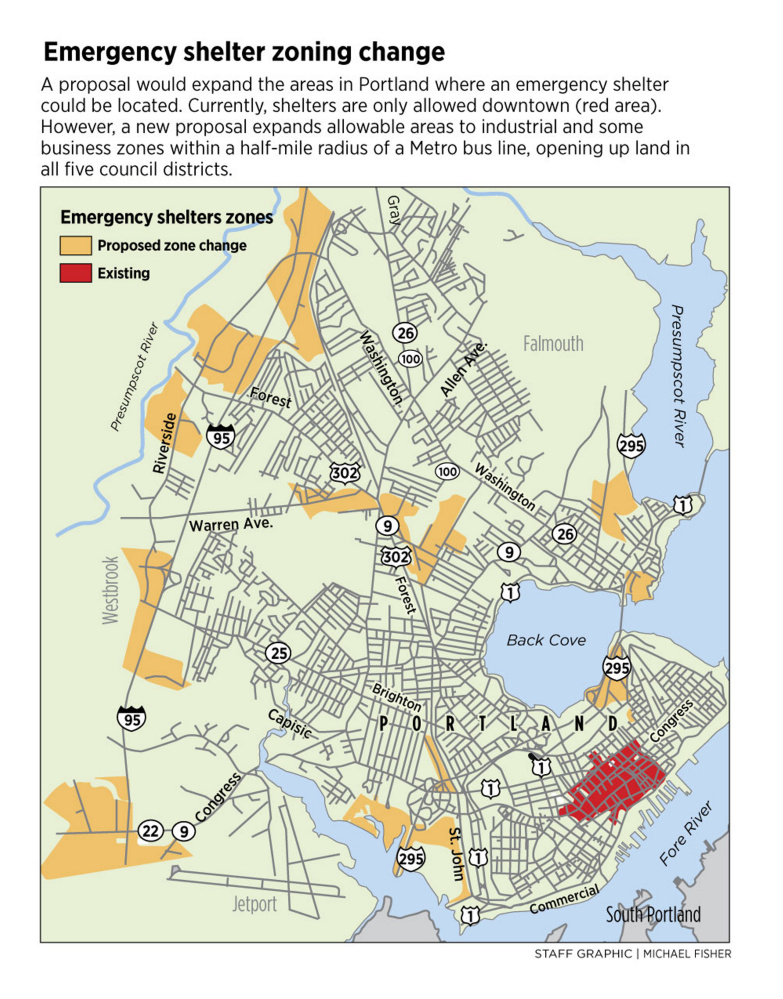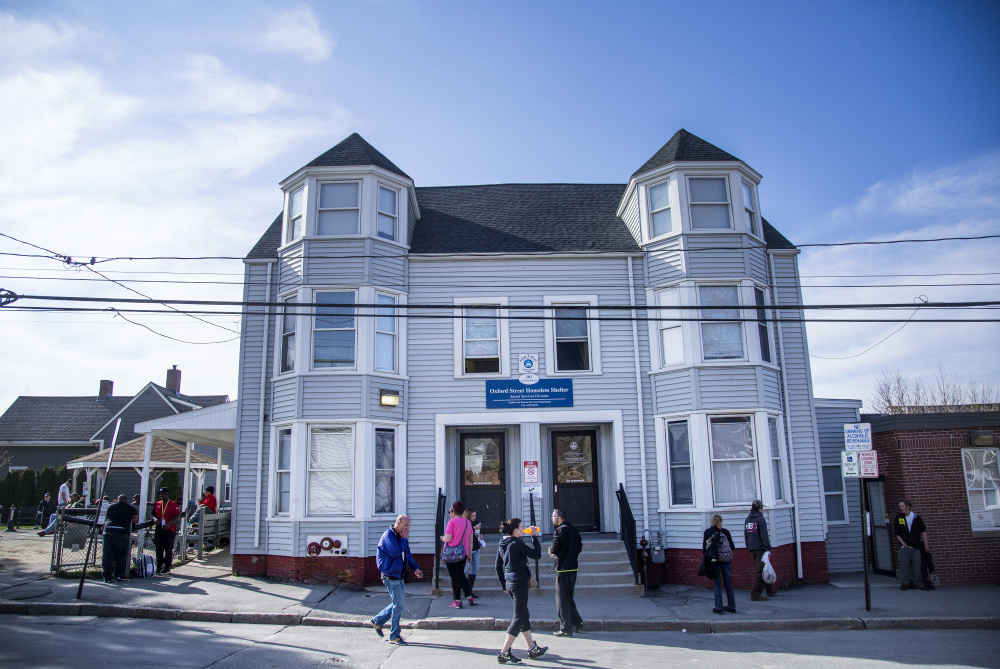Maine’s largest city is laying plans for a new, modern emergency shelter that could operate 24 hours a day and consolidate a variety of services to support and rehouse people facing homelessness.
And it could be located in the industrial outskirts of Portland, away from downtown where services are now concentrated.
Last week, the Planning Board advanced a proposal to the City Council that would allow shelters as conditional uses in industrial zones and other business zones. Currently, homeless shelters are only allowed in Portland’s downtown zone. The proposal also adds conditions that shelters must meet to be approved.
“I really feel like it’s an essential first step,” said City Councilor Belinda Ray, who oversees the Health and Human Services Committee, which drafted the proposal. “It’s the first step of a long journey that will provide us with a facility to offer better services and also a better environment for residents and staff.”
The council could vote on the new zoning rules as early as June 5. Next year’s budget includes $125,000 in preliminary planning work. Ray said creating a group to select a location and finalize what type of facility and services should be included will be among the committee’s top priorities. She noted that the change would open up areas in all five council districts.
Meanwhile, city officials have already commissioned a conceptual floor plan of a modern, single-story shelter that complies with the new zoning rules. That plan, which contemplates a 186-person shelter, was included in the Planning Board’s meeting packet.
Portland has had a policy of providing shelter to anyone in need since the 1980s. Since then, the number of homeless people has increased significantly, while other nonprofit shelters have closed, due to a lack of funding.
Portland has seen a surge in homelessness ever since the 2008 recession. Although officials have made strides in placing long-term shelter stayers in permanent housing, the number of people using a shelter has remained fairly consistent. In January, an average of 443 people were staying in city’s six shelters, which also serve people from other Maine communities, other U.S. states and people from other countries.
The city’s Oxford Street Shelter has 154 beds and is only open 6 p.m. to 8 a.m. during the week and 1 p.m. to 8 a.m. on weekends, an arrangement that forces people back onto the streets of downtown Portland during the day. The number of people seeking overnight shelter routinely exceeds capacity, requiring the use of overflow space at the nonprofit Preble Street, which can accommodate 75 people.
City Manager Jon Jennings said the three-story structure on Oxford Street is not safe for either staff or people seeking shelter.
“The current shelter is an abomination and that’s not a reflection of city staff, but of how we’ve essentially warehoused people in an old apartment building,” Jennings said. “What people see on Oxford Street today would be very different than what they’d see in a new shelter.”
City officials have been researching options for a new shelter for over a year. In addition to looking at best practices across the country, officials visited shelters in Massachusetts and in Bangor. Shelters in Cambridge and Quincy, Massachusetts, were located away from downtown areas, but were open 24 hours a day and contained food, counseling and housing services on site.
Opening up new areas
The new zoning rules would allow emergency shelters in industrial zones and business zones along the city’s western-most border, as well as along Warren Avenue and around Morrill’s Corner. Areas in Libbytown, St. John Street, Marginal Way and Anderson Street in East Bayside, and East Deering would also be opened up.
However, the new zoning rules would require shelters to be located within a quarter-mile of a Metro bus route. That distance could be extended to half a mile if the shelter provides daytime indoor shelter space and develops a plan to help stayers use public transit.
Other conditions include requiring a management plan that would in part ensure the safety and security of stayers and staff as well as address any concerns from neighbors. A shelter must also provide an outdoor area for stayers that is screened in, and provide laundry service, showers, a kitchen, pantry and secure storage, among other things.
Much of the new property opened up by the new zoning is located on the outskirts of the city.
Mayor Ethan Strimling said he would support a new shelter on the outskirts, as long as access to services and transportation is maintained.
Strimling said he has also reached out to surrounding communities in the Metro Coalition – South Portland, Westbrook, Cape Elizabeth, Scarborough and Falmouth – about taking a more regional approach to building and funding homeless shelters.
“It was a good first step,” Strimling said. “Surrounding communities … were interested in exploring further how we might be able to work together.”
But not everyone is on board with the idea of moving the shelter too far from downtown.
Mark Swann, executive director of Preble Street, a nonprofit social service agency that runs a soup kitchen and day shelter downtown, said Wednesday that he generally supports the city’s efforts to open more zones to emergency shelters, but worried about locating them on the outskirts of town.
“Preble Street also supports that idea in theory, but would also want to be sure that any new zoning would not simply be pushing poor people into industrial parks and the like in an effort to hide the problem,” Swann said. “Besides the obvious concerns about transportation and access to services, we also feel that being part of a community and having a sense of belonging is critically important to a person’s health, recovery and life.”
The conceptual floor plan for a new shelter shows a single-story building with 126 beds for men and 60 beds for women. The sleeping quarters for men and women, which include restrooms and showers, are separated by a laundry room and a central office. The plan includes a dining room for 136 people, and outdoor park, locker room and private rooms for counseling.
Dawn Stiles, the city’s Health and Human Service Director, said the city has not finalized a plan or location for a new 186-person shelter. Neither Stiles, nor the head of the city’s planning office, could say whether zoning change would open up any city-owned parcels.
“We do not have a location and have not begun a search – the rezoning is the first step in the process,” Stiles said.
When asked for additional information about the floor plan, City Hall spokeswoman Jessica Grondin said the plan was “based on history, experience and estimated need with the on-site services.” However, she further clarified that the plan was not a final draft, but it did include the items the city would like to see in a new shelter.
Where there is space
Some advocates, however, would like the city to build smaller shelters in different parts of the city.
Bill Higgins, who has been homeless in the past and is now an advocate for the Homeless Voices for Justice, said he would like the city to build three or four smaller shelters throughout the city, rather than building one large facility. “It needs to be dispersed,” he said, pointing to the impact the existing shelter has had on Bayside.
During Tuesday’s Planning Board meeting, city officials acknowledged any new shelter would likely be built far from the downtown area.
“A lot of those areas are off the peninsula,” Planning and Urban Development Direct Jeff Levine said. “That’s where there’s space.”
Although the Planning Board voted 6-1 to send a positive recommendation to loosen the zoning to the City Council, some board members were concerned about putting a shelter in an industrial zone, especially one on the outskirts of town.
Board member Carol Morrissette cast the only dissenting vote on Tuesday, strictly over the inclusion of the industrial zones.
“I don’t think anyone should be living in an industrial zone – that’s not what the intention of the zone is for,” Morrissette said. “I know that’s an integral part of it, but I do look forward to the fresh approach to housing our homeless that the city of Portland is taking on.”
Board member Brandon Mazer said he was initially skeptical of opening up industrial areas, but has come to realize that it may be the only area where a single-story shelter meeting the city’s needs could be built.
“If it’s a choice between not having a modern shelter and having one, I’d rather have one that works, wherever it is,” Mazer said.
Nonprofit social service agencies and housing providers such as Community Housing of Maine, the Milestone Foundation and the Shalom House all supported the proposal.
Jeff McNally, director for community outreach at the Milestone Foundation, a nonprofit that operates a shelter for people who are intoxicated, noted the possible benefits of moving homeless people out of the downtown area.
“Anyone who is trying maintain any sort of sobriety that’s staying in Bayside has a hard hill time to climb. It’s where a lot of the dealers go and hang out,” he said.
If the proposal is approved by the council, Jennings said staff would like conduct an analysis of the specific properties in the new areas. He said the city could either build on land it already owns, or look for a private landowner to partner with.
“We’re open to any possibility,” he said. “The public-private partnership is something we’re looking at across-the-board.”
Randy Billings can be reached at 791-6346 or at:
Send questions/comments to the editors.




